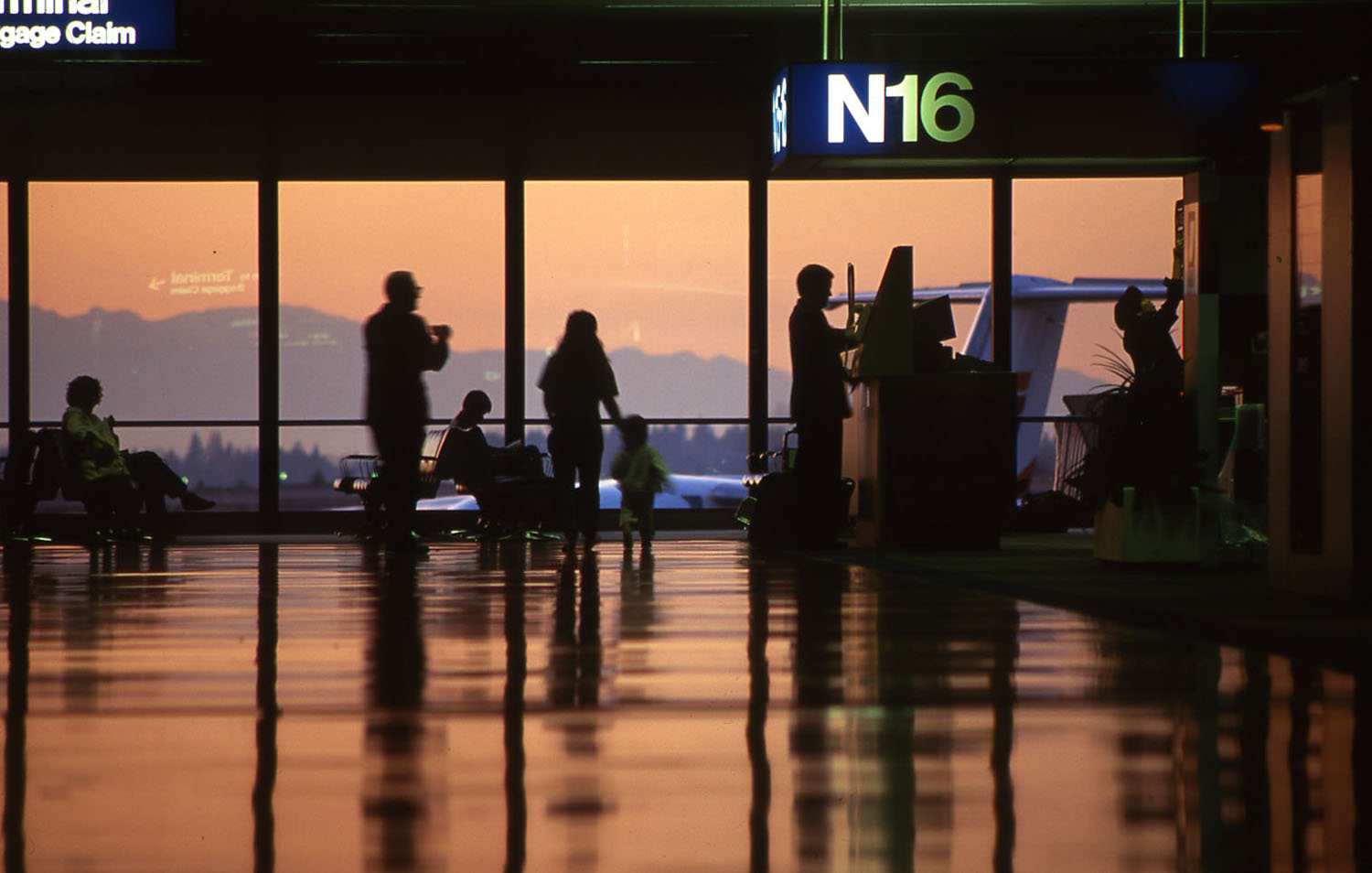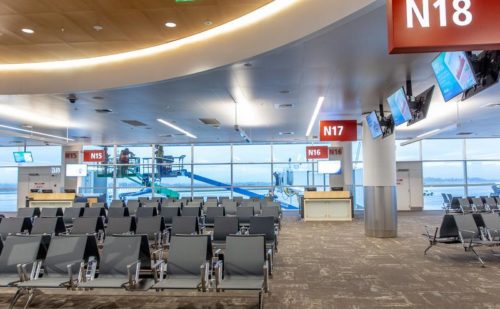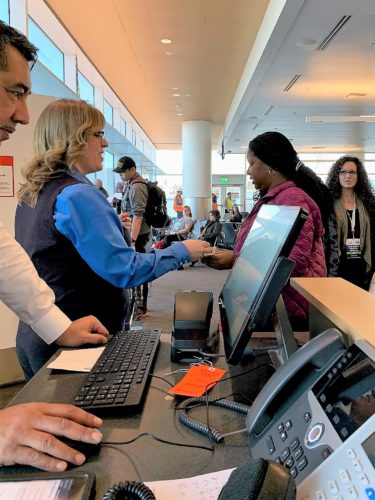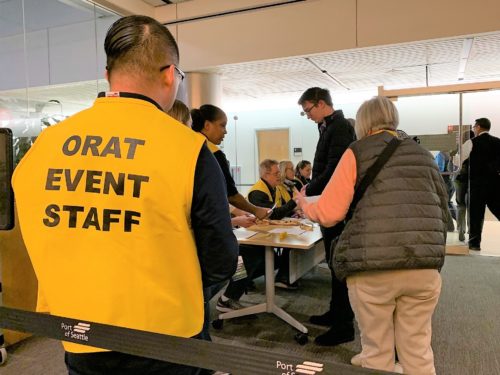
Earlier this month, more than 200 ‘fake’ passengers showed up at Seattle-Tacoma International Airport.
They weren’t working a scam. And they weren’t there to protest anything.
Instead, they were there volunteering to help Sea-Tac airport test the operational readiness of a satellite terminal undergoing its first major expansion and modernization in 45 years.
Happy to be spending their Saturday morning at the airport, 3-year-old Ari Weinstein and his 6-year-old brother, Micah, were toting tiny rolling suitcases for the day’s pretend flight.

“We thought it would be fun to check-out the new airport addition and see how easy it was for kids,” said the boys’ dad, Ben Weinstein, a Boeing engineer, “I’m also curious to see how the latest airport design works with new airplanes.”
72-year-old Vicki Lockwood and her 93-year-old mom, Ruby Griffin, had signed up to be testers too.
“I wanted to see what was happening so I can tell my friends at the senior center what it’s all about,” said Griffin.
Travel agent Rufo Calvo volunteered as a tester so he could get an early look at the new terminal area and tell his clients what to expect. And Toffee Coleman, who travels four or times a month for her job in marketing and sales, was curious to find out what the expanded terminal would offer for business travelers. “I hope it measures up to the central terminal in terms of ease of use, amenities and accessibility,” she said.

Opening day for the first phase of Sea-Tac airport’s expanded North Satellite was less than two weeks away. The bathrooms, drinking fountains, food concessions and visual paging systems weren’t quite ready, but this “passenger-flow simulation” was testing the journey between the main terminal and the expanded satellite as well as the process of boarding and deplaning a flight at one of the new gates.

“We’ll also be asking the volunteers if the temperature in the terminal is comfortable and if they can hear the overhead announcements clearly,” said Charles Goedken, Sea-Tac’s senior manager for Operational Readiness, Activation and Transition, or ORAT, which is the system of best practices many airports use from the design stage forward to make sure a new airport or new terminal is ready for opening day.

“What you try to do is to start working early with the planning and construction team so that when the airport or the facility is open everyone knows what to do,” said Lance Lyttle, the managing director of Sea-Tac Airport, “You don’t want to find issues on opening day; you want to find them before opening day.”
Lyttle was with Hartsfield-Jackson Atlanta International Airport and Houston’s William P. Hobby Airport when each opened new terminals and says no airport wants to relive the opening glitches experienced by Heathrow and Denver airports.
In the early 1990s, the high-profile failure of an expensive, computerized baggage-handling system delayed the opening of Denver International Airport by 16 months and increased the construction budget by millions of dollars.
After that, “DEN returned to manual baggage systems,” said Denver International Airport spokeswoman Alex Renteria.
In 2008, the grand opening of Terminal 5 at Heathrow Airport’s turned to mush thanks to a cascading series of staffing and baggage-handling problems that forced British Airways to suspend luggage check-in and cancel more than 200 flights over four days. Thousands of passengers missed their flights and more than 15,000 pieces of luggage were delayed.
“If you have a failed opening of a facility it lives as part of your reputation forever,” said Sea-Tac Airport’s Lance Lyttle, “People use it as an example. And not in a good way. Heathrow underestimated the value of ORAT. But the next time [the opening of Terminal 2, in 2014] they went overboard and got it right.”

New terminals and terminal upgrade projects are underway at all three New York-area airports and at airports in Istanbul, Singapore, Salt Lake City, San Francisco, New Orleans, Pittsburgh and many other cities and testing is key to those projects.
At Turkey’s new international in Istanbul, which is expected to be fully open by March, 2019, the ORAT (Operational Readiness, Activation and Transition) team reported for duty more than 20 months ago.
“More than 60,000 airport community staff have gone thru a familiarization and training program,” said Stephan Schwolgin, Istanbul Airport’s ORAT project manager, “More than 175 trials have been conducted with nearly 10.000 fake passengers and 7 real aircraft.”
The experience of unbiased, fake passengers is valuable for gathering feedback on everything from wayfinding and flight information display systems to walking distances and the availability of power sockets, said Schwolgin.
On February 6 Finland’s Helsinki Airport will hold a test day with more than 200 fake passengers at the airport’s new central plaza, called Aukio, which will serve both departing and arriving passengers.
“We will test the functionality of services and passenger paths, especially the state-of-the-art security check with a full body scanner,” said Joni Sundelin, Helsinki Airport’s executive director, “The trial day includes testing not only of the passenger flow, signage, restaurants and bathroom facilities, but also services and processes for passengers with reduced mobility.”
During a previous test of a different part of the airport, “There was a funny issue with the toilets,” said Sundelin. “Test passengers were wearing brightly colored vest and when the testers entered the bathroom all the automatic water taps with motion sensors activated. Apparently the sensors were so sensitive they recognized the bright yellow and orange vests moving even from the distance,” said Sundelin.
When testing with fake passengers for San Francisco International Airport’s Boarding Area E, “We learned there was some signage too small or not universal enough,” said Kristi Hogan, Associate Vice President, Transportation for engineering firm AECOM, “No one could find the yoga room.”
For a passenger-flow simulation scheduled for June 6 in advance of the July opening of 9 new gates at SFO’s Terminal 1, volunteers of all ages and abilities will be asked to test the terminal signage; flush toilets and use faucets and automatic hand dryers in the bathrooms; locate flight display boards; test the Wi-Fi and make phone calls on their cell phones.
“We’ll have some fake passengers arrive on the BART train and have others get dropped off at the curb,” said Hogan, “And we’ll also ask them to become arriving passengers and make their way to baggage claim, to taxis or to BART.
Trials and simulations will also soon be underway in advance of the scheduled May 15 opening of the new terminal at Louis Armstrong New Orleans International Airport (MSY)
“These simulations will test everything from parking, ticket counters, security checkpoints, flight monitors, restrooms, gates, concessions, emergency exits, lost and found, and ground transportation,” said MSY spokeswoman Erin Burns.
Emergency response systems, baggage systems, PA systems and everything on the facility maintenance side will also get tested, said Burns, including simultaneous toilet flushes & sink use, seating, power access and severe weather operations.
Employees and fake passengers will performed many of these tests but, with perhaps the Denver and Heathrow terminal debacles in mind, Burns said data on how MSY passengers might experience the facility will also be gathered during sneak peaks events held in the terminal right up to the official opening.
Thanks for visiting Stuck at the Airport. Subscribe to get daily travel tidbits. And follow me on Twitter at @hbaskas and Instagram.